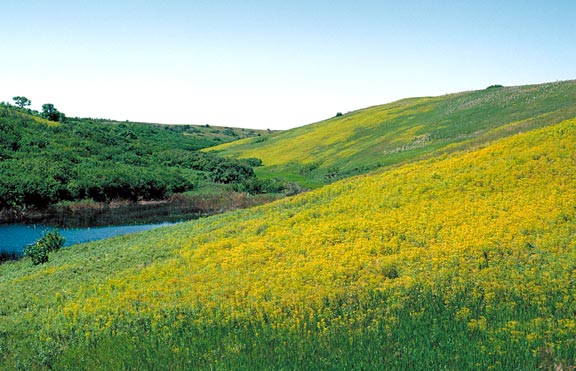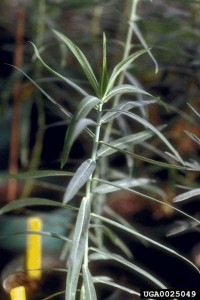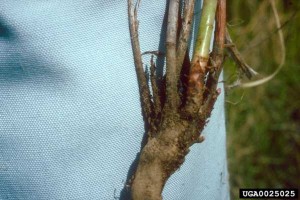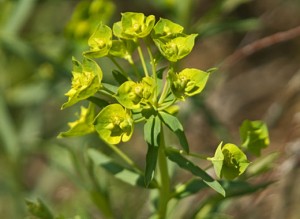A large field covered in a thick layer of yellow and green vegetation as far as the eye can see. It’s quite picturesque, yes? But there is a reason why other plants cannot be seen.
The yellow-green plants in the above image are an aggressive invasive species. Euphorbia esula or leafy Spurge is a native plant of Europe and Asia but is now spread to many places including United States, Canada, and Argentina. This plant out-competes others for water and nutrients. It has a devastating toll on plant and animal diversity as well as causing huge economic damage.
Appearance
Leafy spurge has 3 main parts that serve important functions.
Stems and Leaves
The plant has an average height of 20-90cm. Along the stem are many bluish-green leaves for carbohydrate production. A milky sap excretes from the stem. This sap can cause blindness if it comes into contact with eyes. Insects are attracted to the milky sap, aiding in pollination. Leafy spurge contains latex which is off-putting to cattle so they avoid grazing in areas where the plant occurs.
Roots
A major roll in its invasive capability, Leafy spurge has an extensive root system that grows laterally and horizontally. The roots are hard with a bark-like quality for protection. Pink root buds grow from the roots. As Leafy Spurge grows, the roots form a complicated system making it difficult to remove.
Flowers and Seeds
Clusters of flowers are protected by yellow bracts (leaf-like petals) which give it a yellow hue. Seeds are stored in 3-celled capsules which explode expelling seeds up to a distance of 15 feet. They are easily transported by water, roads, animals and agricultural equipment.
Path of least resistance
Leafy spurge quickly infests areas where soil is repeatedly exposed (disturbed). This is when competition from native plants is reduced. As leafy spurge is tough, it is able to grow and out-compete native plants in disturbed areas while avoiding areas where vegetation is already established. Disturbances include human interaction and abiotic and biotic factors. The plant often grows along roadsides, ATV (all-terrain vehicle) trails, housing developments, near water, and urban areas. Preference is for dryer land with limited shade. One of the major causes of spread is human activity (cultivation equipment, vehicles, power line equipment, transport of contaminated weeds).
Leafy Spurge does not compete well in areas where vegetation is established. Forested areas, high shade areas, and poorly drained soils are some areas where the plant is not abundant. Regularly cultivated fields stop the plant from establishing its root system; however they are abundant along the borders of these fields.
Damage
According to the Global Invasive Species Database, there has been over 2 million hectares of damaged rangelands in the Northern Great Plains as well as over $100 million per year of economic damage. They reduce recreation areas where wild-life is prominent.
Management methods
Leafy spurge is costly and time-consuming to control. Early detection is the most effective way of preventing spread. Mechanical methods like tilling, mowing, and pulling are not effective because of its root system. According to Weeds BC, the best strategy is a combination of prevention, biocontrol, chemical control, and seeding to perennial grasses. Apthona nigriscutis (flea beetle) has shown to be an effective form of biocontrol. Leafy spurge provides nutritious forage for sheep however this is only a temporary solution because the plants return once sheep are removed. Areas with large infestation require biocontrol followed by long term seeding and management.
Our Project Goal
As you can see, Leafy Spurge is a unique and aggressive invasive species. It is important to prevent its growth and spread at an early stage as it is costly to manage. Our goal is to help inform others about the harmfulness of the plant and the areas where it is prone to grow in order to prevent future damage.



